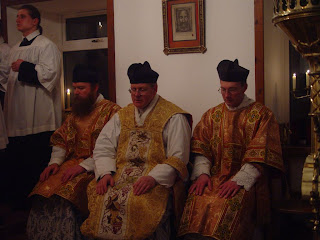On St Peter Martyr
Peter was born around 1205 in Verona, Italy. His parents were Catharists, but as there were no Catharist teachers in Verona, Peter attended a Catholic school. His uncle stopped him in the street one day and demanded to know what the school was teaching him. In response, Peter began to recite the Apostle's Creed, affirming his belief that God created all things spiritual and material. His uncle told him that he was wrong, and tried for some time to convince the young saint that the heretics had the answer, but he could not shake Peter's faith.
Peter later attended the University of Bologna. Although Bologna was infamous for its immoral environment, Peter continued in his life of sanctity. It was during his studies here that he learned of the Dominicans, who were holding their second General Chapter in Bologna in the year 1221. Peter presented himself to the new order and humbly asked for the habit, and was given it by Dominic himself. Peter was among those present at the holy founder's deathbed a few months later for his final blessing.
One thing that certainly characterizes Peter's life is mortification, which he began when he received the habit. In fact, his penances as a novice were so severe that they affected his health. He soon recovered, and thenceforth undertook only those mortifications approved by his spiritual director, which were still severe enough. As a student in the order, Peter constantly devoted himself to both study and prayer.
Peter spent his time in exile living a life of prayer, mortification, and service to his brothers. When the order finally discovered that he was innocent, he was called forth from his exile and he resumed his preaching. Though Peter did not think so at the time, his period of exile had been a blessing, for his preaching abilities dramatically improved because of it. Pope Gregory IX was so impressed with Peter's preaching that, about the year 1232, he appointed Peter to the position of Inquisitor General of the Faith. Peter was reappointed to that position under Pope Innocent IV in 1251.
Peter's reputation spread all throughout the land. So many people flocked to hear him preach that they could not fit in the churches, and often Peter had to preach in the streets and fields. In Milan, the people built a portable pulpit to protect Peter from the press of the crowd. Several of the stronger men would carry the pulpit to whatever place in Milan the famous friar was preaching. Many flocked to him because of his reputation as a wonderworker, though his greatest deeds were the conversions he effected in the hearts of his listeners. His holiness was due in no small part to the fact that he persevered in his life of prayer, study, and mortification everywhere he went. He served as prior of Dominican houses at Asti (1240), Piacenza (1241), and Como (1251), and in this post he constantly exhorted his brothers to the conventual observances and to study, especially of the Bible.
Naturally, the heretics opposed Peter, and were frustrated at his continued success. They avoided his preaching at all costs. Finally, four of them were driven to plot Peter's death. They decided to hire an assassin for 40 Milanese Lire. A man by the name of Carino (also known as Peter Balsamone) agreed to undertake the task, choosing as an assistant one Albertino Porro. Peter soon learned of their plotting, but he would not let it daunt him. On Palm Sunday, March 24, 1252, he was preaching in Milan and said, "I know for certain that the Manicheans have plotted my death, and have deposited money for that purpose. Let them do what they will. I will accomplish more against them than I have done during my lifetime" (O' Daniel, 32). He then traveled to Como, where he was prior at the time.
Almost exactly two weeks later, on Saturday, April 6, 1252, Peter was traveling back to Milan with a companion by the name of Brother Dominic. Carino set out after him, and was joined on the way by Porro. Halfway to Milan, they caught up to Peter in a thick forest near Barlasina. Carino struck the first blow against Peter, opening a wound in his head and driving him to the ground. He then turned on Brother Dominic, wounding him several times (Br. Dominic died a few days later from these wounds). Carino then turned back to Peter, who, being unable to speak, had dipped his finger in the blood flowing from his wounded head and written upon the ground the first words of the Apostle's Creed, which he had recited to his heretical uncle as a boy. Carino thrust his knife into Peter's chest, killing him. Peter was 47, and had worn the Dominican habit for 31 years.
Peter's remains were carried to Milan and turned over to the Dominicans, who interred him at St. Eustorgio's Church. He was well loved, and his death affected many, not the least of whom was his murderer. Carino had been arrested, but soon escaped and fled to Forli. There, he was overcome with horror at what he had done. He repented his heresy in the hands of a Dominican priest, and later became a Dominican lay brother, living a holy life from then on.

















































